Family : Geometridae

Text © Prof. Santi Longo

English translation by Mario Beltramini
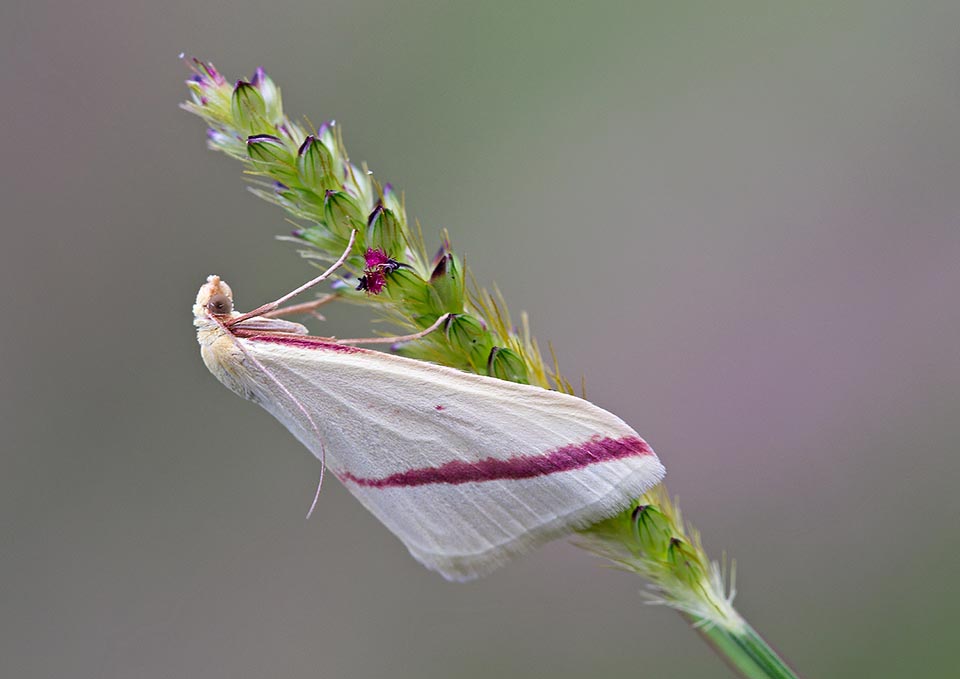
Female in white livery. As the scientific name evokes, the position of the wings of the Vestal (Rhodometra sacraria) while resting recalls the hands clasped in prayer © José Delamano García
The Vestal, Rhodometra sacraria Linnaeus, 1767, is one of the about 35.000 species of Heteroneura lepidopterans, pertaining to the family Geometridae.
The larvae feed on herbaceous and arboreal plants; they are equipped with two pairs of abdominal pseudo legs at the sixth and tenth urite. For walking they must alternately approach and retract the thorax, where are located the legs and the extremity of the abdomen, giving the sensation of measuring the substrate, and from such characteristic comes the name assigned to the family.
The subfamily Sterrhinae, to which pertains the Vestal, includes species whose adults have yellowish grey or greyish pink colourations, with a delicate flight but able to effect long migrations.
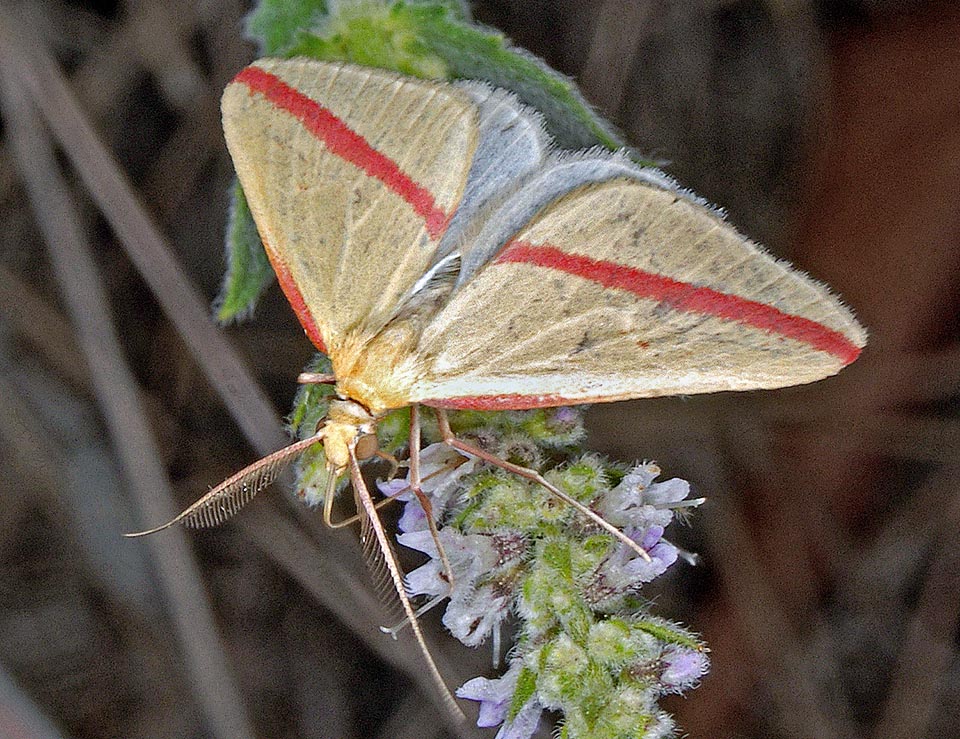
Keeping firm the showy stripe crossing diagonally the fore wings upper side, the colour is very variable, depending on temperature experienced by pupae © Ettore Balocchi
The name of the genus Rhodometra refers to the pinkish colour, from the Greek “rhodos”, more or less intense of the adults especially in the warmest areas and to “metron” that can mean “right measure, limit, term or convenient proportion”; whilst the specific term sacraria recalls the position of the wings of the adults when resting that reminds the hands clasped in prayer.
Zoogeography
The species is spread throughout most of Asia, in North Africa and in southern Europe; in the warmest locations it performs several generations in a year. The adults do long migrations looking for host plants. It is reported also in North America as well as in Chile and Argentina.
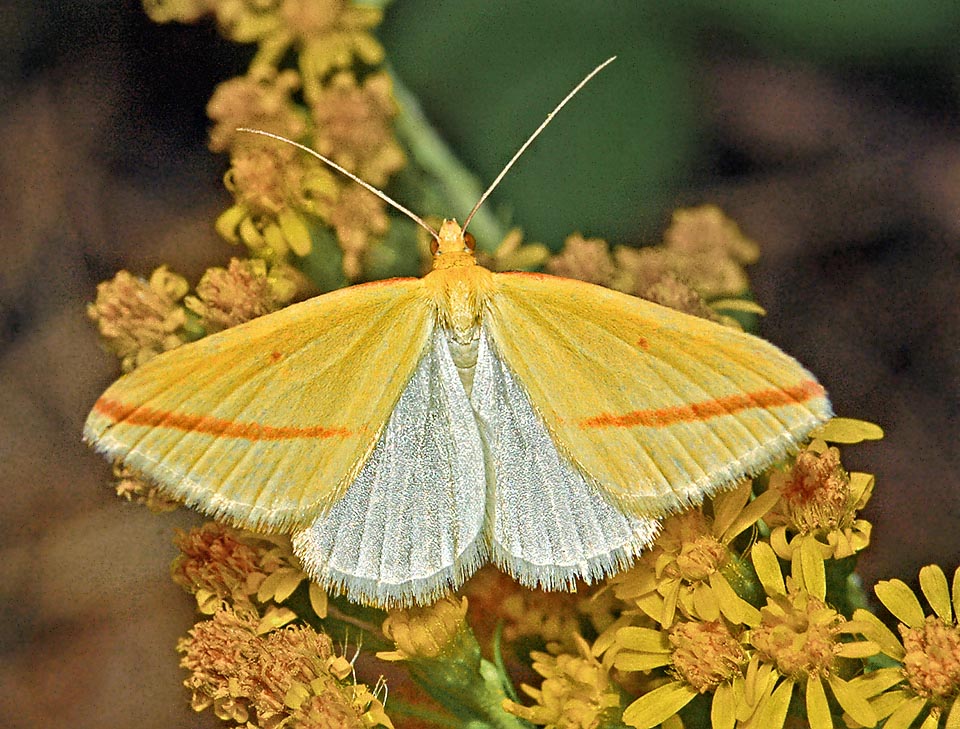
The wingspan of this migratory species, present in Asia, North Africa, South Europe, North America, Chile and Argentina, is only of 2-3 cm © Ettore Balocchi
Ecology-Habitat
The larvae nourish of herbaceous plants of the genera Rumex, Anthemis, Emex, Oxygonum, Persicaria and Rhus. It is one of the most common moths both in the wooded areas and in urban southern centres where the adults arrive attracted by the night lighting. During the day they often stop on the glasses and on the walls of the buildings as well as on the stems and the small branches of the host plants.
Morphophysiology
The body of the adults of the spring generations is about 11 mm long; the head and the thorax are of straw yellow colour. The male adults have bipectinate antennae.
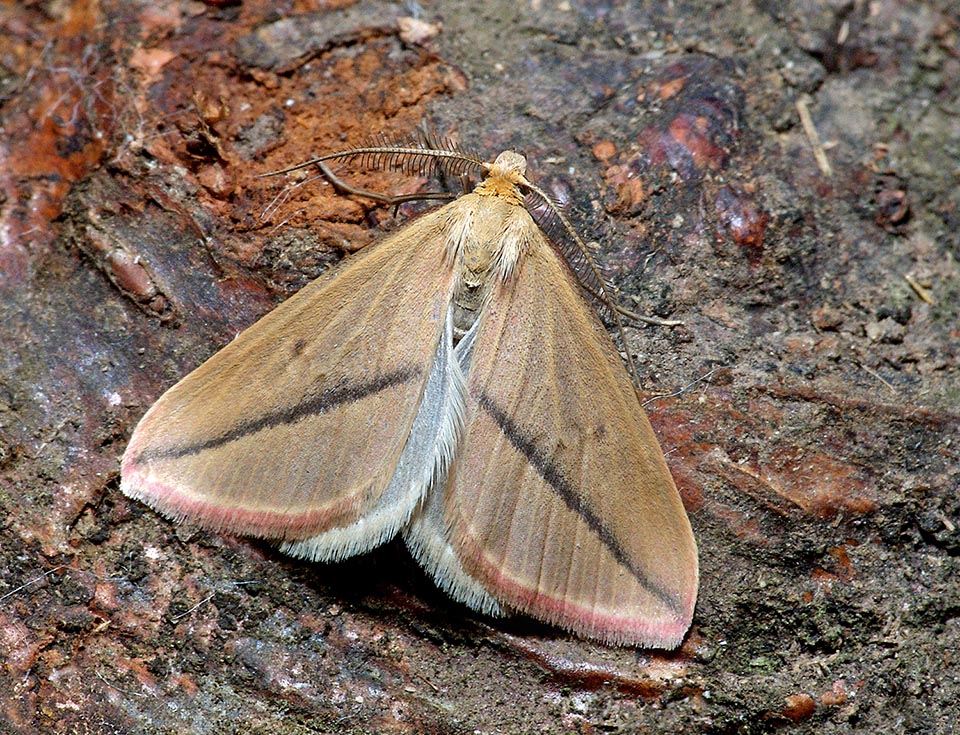
The stripe on the wings, with red hues, can be also black, like in this dark male who has met strong temperatures during the pupation © Patrick Clement
The wingspan varies from 20+ to more than 30 mm. In the adults of the summer-autumn generations, it averagely measures 16-26 mm. The broad fore wings are 12-14 mm long and are whitish or pinkish yellowish, with a characteristic mahogany or pink stripe, that crosses diagonally the upper pagina from the rear edge up to the apex. Often there are present discal spots of the same colour as the most medial line. The rear wings are smooth, with whitish and not marked dorsal sides. The wing fringes are yellowish. In the tibiae of the hind legs are present two pairs of spurs. The abdomen is white.
Then intensity and the extension of the pink pigmentation varies depending on the temperature to which the pupae are submitted during the development; it is more intense in those exposed to higher temperatures.
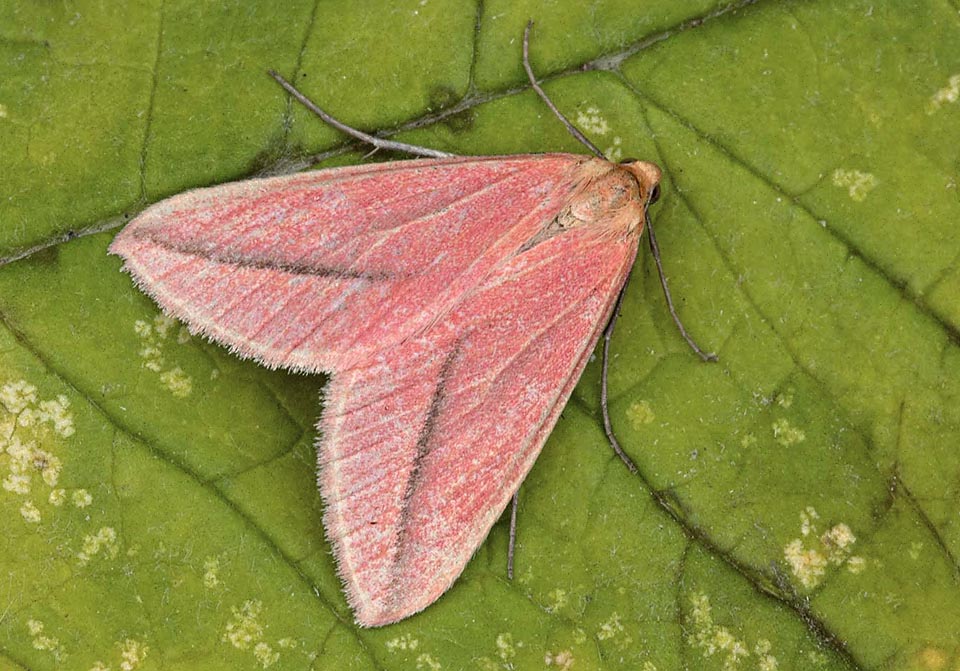
It’s also the case of this female with pinkish hues. The low temperatures during the larval stage produce conversely pale liveries and red bars © Peter Maton
The eggs are relatively long, yellowish, with distinct red spots.
The larvae resemble the twigs of the host plants, among which they blend. When mature they reach a length of more than 30 mm; the body, of pale brown or green colour, is whitish ventrally; the head is relatively small of reddish-brown colour. The forms of green colour present on the back an irregular dark brown or reddish stripe, like the foliar veins of Rumex.
The mature larva transfers on the dried leaves present at the base of the plants where it performs the pupation transforming in chrysalis, of yellowish brown colour, with dark spots, about 1 cm long, with a diametre of about 3 mm.
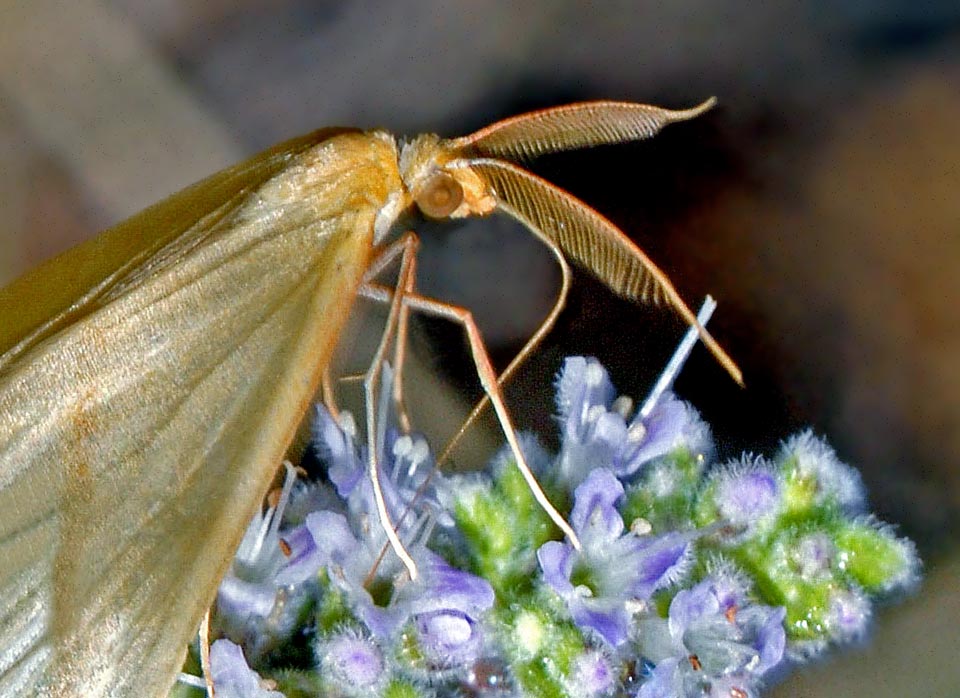
Males are at once recognized due to the bipectinate antennae several sensilla, done to intercept the sexual pheromones released by the virgin females © Ettore Balocchi
Ethology-Reproductive Biology
The adults, during the migrations they do in the night hours, are attracted by the lights; during the day they often stop on twigs or on the stems of herbaceous plants as well as on the walls of rural and urban buildings where, in South Europe, in North Africa and in Asia, are present from April to November.
During the rest they keep the wings parallel to each other. The males, thanks to the numerous sensilla present in the
bipectinate antennae locate the sexual pheromones emitted by the females who, after having been fecundated, go around looking for the host plants where to oviposit guided by the trails of their odours.
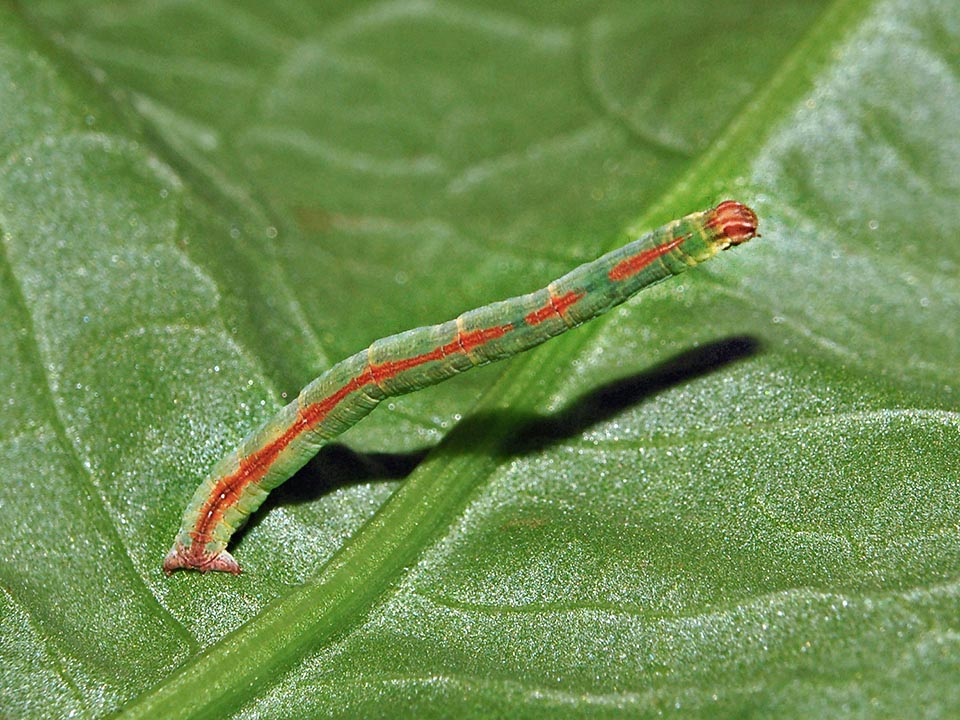
Oligopod larva in erect posture on pseudo legs present at sixth and tenth urite. It moves with compass-like movements like all geometrids. It eats herbaceous plants pertaining to the genera Rumex, Anthemis, Emex, Oxygonum, Persicaria and Rhus. In the warm sites the Vestal may do several annual generations © Ettore Balocchi
In nature the species has several natural foes that parasitize their eggs, the larvae and the chrysalises reducing the density of population. Moreover, the larvae die as a result of viral, bacterial and fungal infections. Some species of parasitoids are known, Braconid Hymenopterans of the genus Apanteles, as well as Tachinid Dipterans such as Compsillura concinnata Meig. Active oophagous parasitoids are some species of Scelionid Hymenopterans of the genus Telenomus, and Trichogrammatidae of the genus Trichogramma.
Synonyms
The Vestal has been described by Linnaeus in 1767 as Geometra sacraria. In 1935 it was transferred by Prout into the genus Rhodometra erected by Edward Meyrick in 1892. The synonyms of sacralis Linnaeus, 1767, in chronological order are the following: labda, Cramer, 1777; sacrals, Thumberg, 1784; fulvaria, Fabricius, 1794; sanguinaria, Esper,1799; minervae, Gistel, 1856; labdaria Guenèe 1858.
→ For general notions about the Lepidoptera please click here.
→ To appreciate the biodiversity within the BUTTERFLIES please click here.
